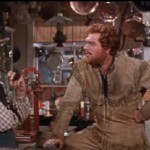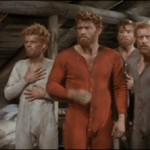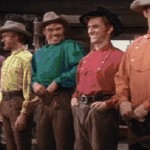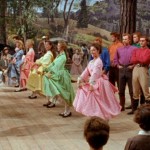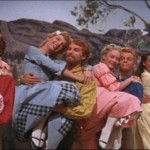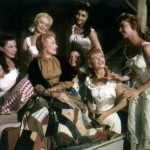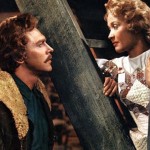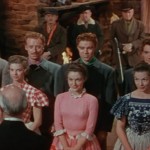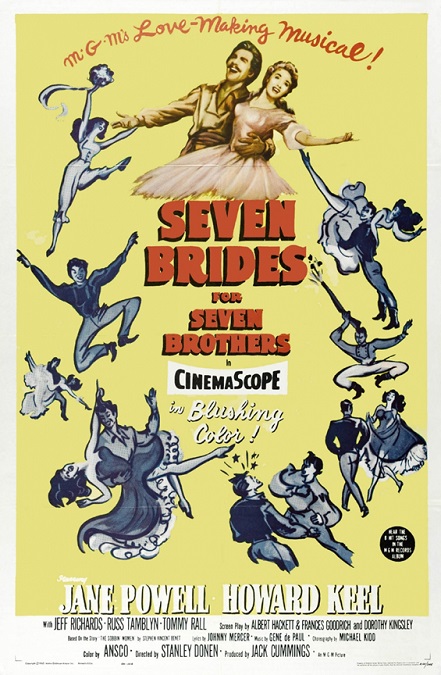
Seven Brides for Seven Brothers – 1954
This was a fun movie with an abysmal plot. The acting was questionable, the singing was passable, and yet the dancing was incredibly clever. I keep telling myself that I didn’t like the film, but I keep coming back to certain things that I can’t help but like. I seem to be a bit conflicted.
First off, the music was largely unmemorable, at least to my modern ears. The cast was, fortunately, made up of professional dancers, which was good, because there was a lot of high-energy, complex dancing. However, it is interesting to note that a couple of the brothers and almost all the brides had to have their singing voices dubbed by other vocalists. Still, there were a few songs that, while I can’t remember the melodies, were cute and perky.
The ridiculous plot starts off with the eldest brother, Adam, played by Howard Keel, as he goes to town to get food, a wife, and some supplies. The guy is such a moron that he thinks that he can pick any woman he sets his eyes on and take her home as his bride. Reality be damned! He decides on hard-working and beautiful Milly, played by Jane Powell. Having seen her serving food to a bunch of rowdy men at an inn, he corners her and asks her to marry him. No woman in her right mind would say yes to a complete stranger. But inexplicably, she does. Reality be damned, indeed. Fortunately, true love blossoms between them with lightning speed.
She wants to be able to cook and clean for just one special man instead of a bunch of uncouth rabble-rousers. After the instant marriage, she finds out that she will be expected to cook and clean, not just for Adam, but for his six brothers as well. But she uses her feisty, feminine ways to whip the rough and sloppy siblings into shape, within a matter of weeks, no less. Really though, it only took one quick song and dance number to teach them all to be perfect gentlemen. Reality be damned!
Then came the barn-raising. There was two phases to this sequence: the dance and the fight. The dance was intricate and fun to watch. It seemed to be the centerpiece of the entire film. There were the brothers who were going out of their ways to impress and dance with the young girls. The young men of the town were also trying to dance with the maidens. The back-and-forth squabble eventually turned into a contest to see which group of men was manlier than the other. The choreography was incredible as the girls get pulled back and forth between the two factions. Then, the fight sequence wasn’t so much of a dance as it was… a well-choreographed fight.
After that, the brothers were all in love and pining for their lovely young girls. So, based on one of Milly’s books containing the ancient Roman legend, the Rape of the Sabine Women, they decide to get their brides. In the context of the mythological story, the word “rape” actually means “abduct” and not sexual violation. So they go to town and use force to kidnap the horrified young girls. They whisk them away to their cabin up in the mountains, causing a snowy avalanche behind them, ensuring that the girls would be snowed in with them for the duration of the winter.
Milly is appalled by their behavior. She welcomes the girls into her home while forbidding the brothers to enter. What follows is the most ridiculous part of the plot of all. In modern terminology, we might call it Stockholm Syndrome. The traumatized women are, for some reason, so turned on by the masculine behavior of the men that they begin to, uh, lust after them… I guess? Then when spring comes, every last girl falls madly in love with her particular captor, so much so that when the men of the town come to rescue them, they all run and hide, begging to be left where they are. Reality be damned!
But it was the film’s dancing that made the movie fun for me. The choreographer, Michael Kidd, really pulled out all the stops and came up with some wonderful dance numbers that were an integral part of the plot. The dance actually helped tell parts of the story, which is no wonder. The dance sequences, and the fight sequences for that matter, all had an air of ballet to them. And what is ballet but stories told through nothing but a marriage of music and dance? So that aspect of the film was good, but a Best Picture nomination? I’ll just say I’m glad it didn’t win.
